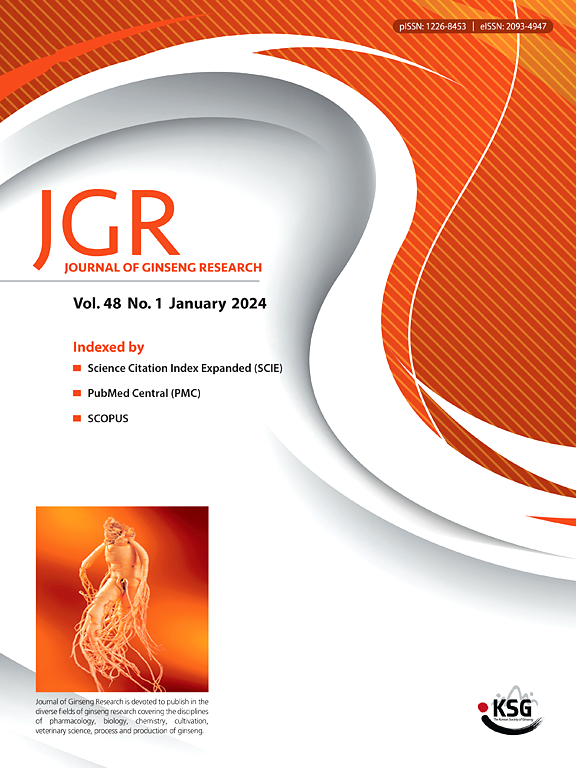Ginsenoside Rg5 alleviates radiation-induced acute lung vascular endothelium injury by reducing mitochondrial apoptosis via Sirt1
IF 6.8
2区 医学
Q1 CHEMISTRY, MEDICINAL
引用次数: 0
Abstract
Background
Ginsenoside Rg5 possesses potent anti-oxidative, anti-inflammatory, and cytoprotective properties. This study explored the protective effects of ginsenoside Rg5 on radiation-induced pulmonary microvascular endothelial cells (PMECs) injury and the associated molecular mechanisms.
Materials and methods
C57BL/6 mice were used for in vivo studies and primary human PMECs (PPMECs) were utilized as in vitro models. Mice with or without ginsenoside Rg5 pretreatment were irradiated by varying doses. Lung tissues were analyzed for histopathological changes and the expression of endothelial markers. In vitro, PPMECs were irradiated with or without ginsenoside Rg5 pretreatment and analyzed for apoptosis, oxidative stress, mitochondrial function, and endothelial barrier integrity.
Results
Ginsenoside Rg5 pretreatment attenuated radiation-induced acute lung damage, preserved endothelial cell junction integrity, and maintained endothelial barrier function in vivo. In vitro, ginsenoside Rg5 significantly reduced IR-induced oxidative stress, apoptosis, and mitochondrial dysfunction in PPMECs. Ginsenoside Rg5 suppressed radiation-induced Mfn2 acetylation and proteasomal degradation via Sirt1-mediated deacetylation, thereby preserving mitochondrial dynamics and integrity. The protective effects of ginsenoside Rg5 on the integrity of mitochondrial and endothelial tight junction proteins and barrier function were also Sirt1-dependent.
Conclusions
Ginsenoside Rg5 exerts a protective effect against radiation-induced endothelial injury by modulating mitochondrial dynamics and function, as well as maintaining endothelial barrier integrity, in a Sirt1-dependent manner.

人参皂苷Rg5通过Sirt1减少线粒体凋亡,减轻辐射引起的急性肺血管内皮损伤
人参皂苷Rg5具有有效的抗氧化、抗炎和细胞保护作用。本研究探讨人参皂苷Rg5对辐射致肺微血管内皮细胞(PMECs)损伤的保护作用及其分子机制。材料与方法体内实验采用sc57bl /6小鼠,体外实验采用原代人PMECs (PPMECs)模型。用人参皂苷Rg5预处理或不预处理的小鼠进行不同剂量的辐照。分析肺组织病理变化及内皮标志物的表达。在体外,分别在人参皂苷Rg5预处理或不预处理的情况下照射ppmes,并分析其凋亡、氧化应激、线粒体功能和内皮屏障完整性。结果人参皂苷Rg5预处理在体内可减轻放射性急性肺损伤,保持内皮细胞连接完整性,维持内皮屏障功能。在体外,人参皂苷Rg5显著降低ir诱导的PPMECs氧化应激、细胞凋亡和线粒体功能障碍。人参皂苷Rg5通过sirt1介导的去乙酰化抑制辐射诱导的Mfn2乙酰化和蛋白酶体降解,从而保持线粒体动力学和完整性。人参皂苷Rg5对线粒体和内皮紧密连接蛋白完整性和屏障功能的保护作用也依赖于sirt1。结论人参皂苷Rg5通过调节线粒体动力学和功能,维持内皮屏障的完整性,以sirt1依赖的方式对辐射诱导的内皮损伤具有保护作用。
本文章由计算机程序翻译,如有差异,请以英文原文为准。
求助全文
约1分钟内获得全文
求助全文
来源期刊

Journal of Ginseng Research
CHEMISTRY, MEDICINAL-INTEGRATIVE & COMPLEMENTARY MEDICINE
CiteScore
11.40
自引率
9.50%
发文量
111
审稿时长
6-12 weeks
期刊介绍:
Journal of Ginseng Research (JGR) is an official, open access journal of the Korean Society of Ginseng and is the only international journal publishing scholarly reports on ginseng research in the world. The journal is a bimonthly peer-reviewed publication featuring high-quality studies related to basic, pre-clinical, and clinical researches on ginseng to reflect recent progresses in ginseng research.
JGR publishes papers, either experimental or theoretical, that advance our understanding of ginseng science, including plant sciences, biology, chemistry, pharmacology, toxicology, pharmacokinetics, veterinary medicine, biochemistry, manufacture, and clinical study of ginseng since 1976. It also includes the new paradigm of integrative research, covering alternative medicinal approaches. Article types considered for publication include review articles, original research articles, and brief reports.
JGR helps researchers to understand mechanisms for traditional efficacy of ginseng and to put their clinical evidence together. It provides balanced information on basic science and clinical applications to researchers, manufacturers, practitioners, teachers, scholars, and medical doctors.
 求助内容:
求助内容: 应助结果提醒方式:
应助结果提醒方式:


